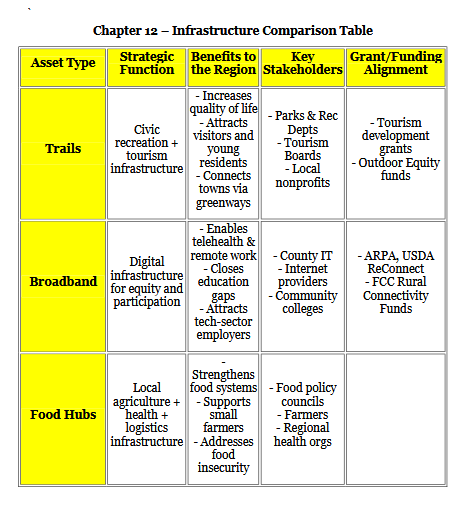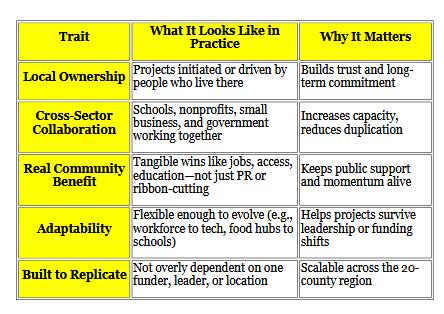Chapter 12
Trails, Broadband, and Food Hubs as Infrastructure
When people think about infrastructure, they picture roads, bridges, and water lines. But in the Foothills Corridor, a different kind of infrastructure is reshaping the foundation of the region—trails that reconnect people to place, broadband that connects them to the world, and food hubs that connect them to one another.
These aren’t amenities. They’re essential systems. They represent a new kind of infrastructure strategy—one rooted in equity, health, access, and resilience. And taken together, they are laying the groundwork for the Foothills to move from fragility to functionality.
Trails: Reconnecting to Place
Trails might seem like recreation. But in the Foothills, they’re economic and cultural lifelines.
Projects like the Wilderness Gateway Trail, the Fonta Flora State Trail, and local greenways in cities like Morganton, Valdese, and Lenoir are doing more than encouraging fitness. They’re attracting tourism, boosting property values, improving mental health, and linking communities that were once isolated from one another.
These trails also serve as visible symbols of forward motion. They show that investment is happening, that care is being taken, and that rural spaces matter. And because they cross county lines, they model regional cooperation in ways few other projects have.
The message is simple: when people have places to walk, bike, and gather, they stay longer, spend more, and feel better. That’s infrastructure. This isn’t infrastructure in the traditional sense—but it might be more essential than asphalt
Broadband: The New Electricity
If trails connect people to place, broadband connects them to possibility. In the 21st century, high-speed internet is no longer a luxury. It’s a prerequisite for education, commerce, healthcare, and civic life.
For decades, large swaths of the Foothills Corridor were digitally dark. Students couldn’t do homework. Entrepreneurs couldn’t launch businesses. Telehealth wasn’t an option. And remote work was impossible.
But recent years have brought serious effort. Mapping has been completed. Public-private partnerships have emerged. Federal and state funding is flowing. And broadband is finally reaching some of the region’s most underserved communities.
This shift is transformational. It means that a student in rural Yadkin County has the same learning opportunities as one in Charlotte. It means a farmer in Caldwell can sell direct-to-consumer online. It means a senior in Polk can see a specialist via video. That’s not convenience—that’s capacity.
Food Hubs:
Feeding the Region, Empowering the People
The Foothills Food Hub, based in Morganton and serving a broader multi-county region, is proving that food systems are just as critical to infrastructure as roads or power grids.
The hub does more than hand out produce. It:
· Buys from local farmers, strengthening regional agriculture.
· Operates a commercial kitchen, supporting food entrepreneurs.
· Distributes meals and boxes to food-insecure households.
· Hosts educational events around nutrition, sustainability, and culinary skill.
In 2023, it moved more than 92,000 pounds of food.
The result? Better health, stronger local economies, and a deeper sense of community agency. The hub turns surplus into sustenance and logistics into empowerment. It’s not charity—it’s infrastructure for regional food security.
Taken Together: A New Definition of Infrastructure
When combined, trails, broadband, and food hubs represent a holistic approach to community development:
· Trails nourish health and mobility
· Broadband unlocks opportunity
· Food hubs anchor resilience and economic justice
They may not look like traditional infrastructure projects. But they’re building something much more vital: an ecosystem of connection—to land, to market, to neighbor.
And unlike mega-projects that often bypass local input, these systems are designed, built, and maintained by local stakeholders. They are grounded. They are flexible. And they are working.
Return The Real on Investment
None of these projects are silver bullets. But they are high-leverage bets. For every dollar invested, they yield social, economic, and public health returns that ripple outward.
They attract tourists. They lower healthcare costs. They reduce food insecurity. They retain young people. They foster pride. And they shift the region’s narrative from scarcity to sufficiency.
This is the infrastructure of the future—quiet, local, and rooted in place.
The Foothills Corridor isn’t waiting for highways and factories to save it. It’s building something better: networks of care, commerce, and community. And that’s a foundation any region would be lucky to have.
Chapter 13
What’s Working—And Why It Matters
Across the Foothills Corridor, not every initiative is flashy. Not every success comes with a press release. But if you look closely—beneath the noise and beyond the traditional playbook—there’s a growing list of efforts that are quietly, steadily changing the game. These projects work not because they’re perfect, but because they’re rooted, responsive, and replicable.
Understanding what’s working—and why—offers a roadmap for how the Foothills can scale its recovery into real, lasting renewal.
1. Local Ownership and Design
Projects led by people from within the community tend to outperform those parachuted in from the outside. Whether it’s the Foothills Food Hub, local trail expansions, or the Valley Datacenter Academy, success starts with local knowledge and accountability.
Why it works:
· Locals know the nuances of need.
· Trust is already built.
· Money stays in the ecosystem.
This isn’t about nostalgia—it’s about functionality. When people are solving their own problems, solutions tend to stick.
2. Regional Collaboration Without Red Tape
In a region where county lines have often been walls, not bridges, the projects that transcend jurisdiction are gaining momentum. The Wilderness Gateway Trail, broadband expansion, and multi-county workforce development plans are examples of this.
Why it works:
· Shared vision reduces duplication.
· Pooling resources stretches every dollar.
· Regional marketing has more weight.
The Foothills has too many small players trying to play big games alone. Collaboration multiplies impact.
3. Integration Across Sectors
Real progress isn’t happening in silos—it’s happening where sectors overlap. When education connects to economic development, when healthcare ties into food access, and when public spaces support small business, the results are exponential.
Why it works:
· Problems are interconnected, so solutions should be too.
· Shared metrics improve alignment.
· Cross-sector trust builds systems resilience.
This isn’t just efficiency—it’s resilience. And it builds community muscle that lasts longer than any one grant cycle.
4. Practical Innovation
Innovation in the Foothills doesn’t mean flashy tech or risky speculation. It means doing more with what’s already here. CVCC partnering with Microsoft. Farmers using food hubs to reach new markets. Empty lots turning into walkable trailheads.
Why it works:
· Lower risk, faster implementation.
· Builds credibility before scaling.
· Avoids overpromising.
In this region, practical beats theoretical. Real-world wins build momentum that hype never can.
5. Rebuilding Trust Through Tangibility
After decades of disappointment, people in the Foothills don’t want talk—they want traction. The projects that are working tend to offer visible, tactile results: a new sidewalk, a staffed-up clinic, a working Wi-Fi signal, a fresh produce box.
Why it works:
· Physical improvements build belief.
· Tangible outcomes re-engage the disengaged.
· Results can’t be spun—they can be seen.
Trust is the foundation of recovery. Tangibility is how it’s earned.
6. Building for the Game Long
Quick fixes aren’t cutting it anymore. The wins that matter are the ones designed to outlive the moment—like multi-phase trails, tech workforce pipelines, and infrastructure that scales with time.
Why it works:
· Creates platforms, not just projects.
· Attracts partners with longer-term vision.
· Builds culture around stewardship, not saviorism.
In a region that’s tired of cycles of hype and heartbreak, this long-view mindset is quietly radical.
Why It Matters
The Foothills Corridor has spent years being told what it isn’t. Now, it’s starting to show what it is: a place where real people, given the chance, can build real systems that serve their communities.
What’s working here doesn’t need to be imported from somewhere else. It needs to be supported, scaled, and stitched together into a fabric of regional renewal.
These aren’t exceptions—they’re foundations. They prove that the region doesn’t need to be saved. It needs to be seen.
And what’s working now can work everywhere—if we pay attention to the how, not just the headline.
Because revival isn’t an announcement. It’s a pattern. And in the Foothills, that pattern is beginning to take shape.
“What the Wins Have in Common”
From Wilkes to Burke to McDowell, these five traits show up again and again in the success stories already unfolding. They’re not magic—they’re models. The playbook is already visible—you just have to stop chasing unicorns and look where things are quietly working.
The early wins we see—new businesses, local initiatives, workforce programs—are encouraging, but they are fragile without deeper systems to support them. Without coordinated infrastructure, investment pipelines, and leadership development, these successes can wither as quickly as they bloom. Sustainable revival demands more than scattered victories; it demands scaffolding that can carry momentum forward.



